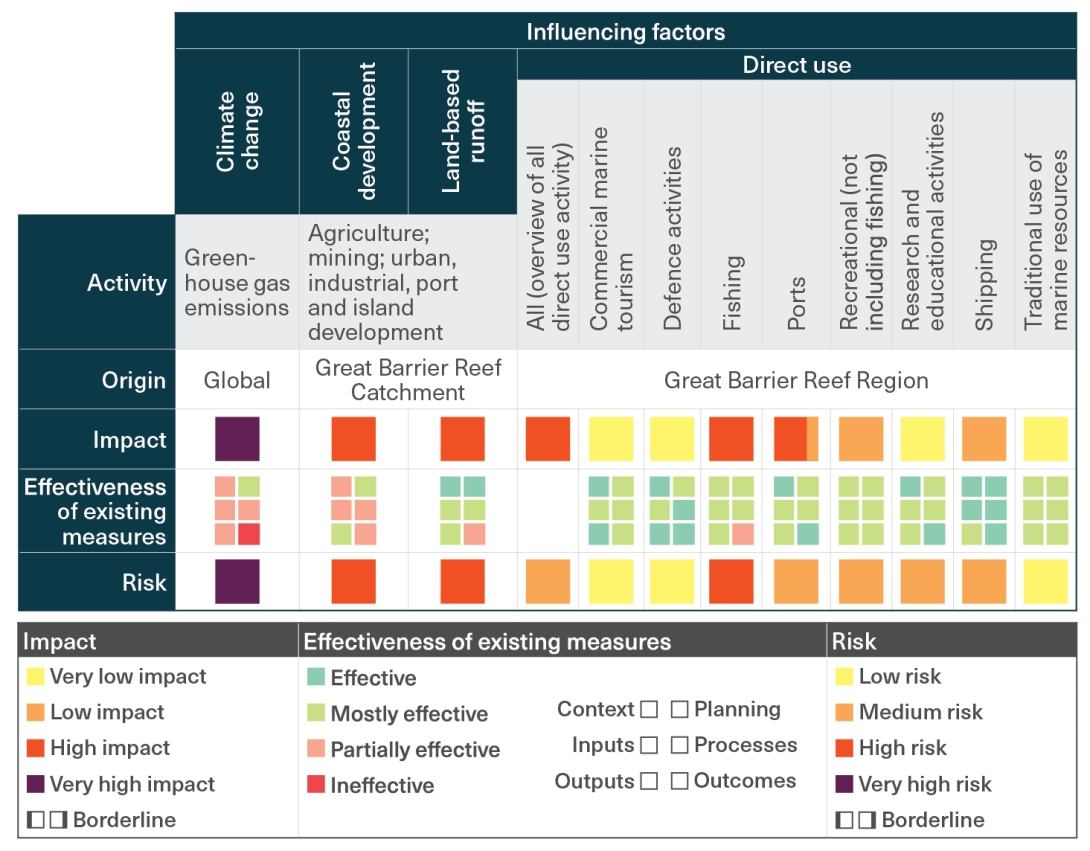Many of the threats with the highest risk levels originate outside the Region, such as those related to climate change, coastal development and land-based runoff. The overall risk associated with climate change (very high) coastal development (high) and land-based runoff (high) have remained the same as in the Outlook Reports for 2009, 2014 and 2019. Management of climate change and coastal development is considered weaker than that for land-based runoff (Chapter 7).
Management of climate change, however, has seen some improvements since 2019 (Section 7.3.9). Specifically, planning and outputs in the management cycle have improved through enhancements to the management of climate change risks, and advances in climate change policy at national, state and local levels. However, outcomes for climate change remain ineffective (Table 7.4).
Many of the threats with the highest risk levels originate outside the Region
In contrast, the management effectiveness of coastal development and land-based runoff have weakened since 2019 with declines seen in most elements of the management cycle (Sections 7.3.10 and 7.3.11). However, ongoing and effective implementation of the Reef Protection Regulations, gully remediation, streambank and site erosion activities, and a net increase in private protected areas may have a positive influence in future on coastal development and land-based runoff (Section 6.4.2).
The overall risk to the Region from direct use remains medium (Figure 9.5). Port expansion activities in Cairns, Townsville and Gladstone consist of capital dredging activities that have indirect environmental impacts, such as damage to the seafloor (Sections 5.7.1 and 5.7.3). Sustained population growth and economic development will continue to increase the demand for recreational activities within the Region, which potentially increases the risk associated with marine incidents (Section 5.5.3). Fishing and ports remain as uses with high impact (Figure 9.5).
Direct uses within the Region are generally well managed; however, the outcomes for managing fishing are considered only partially effective (Table 7.4). Although there have been relatively few improvements in management effectiveness grades for direct use since 2019 (Table 7.4), advances through the Reef 2050 Plan and ongoing fishing reforms may see benefit in the future.
Figure 9.5
Management effectiveness, impacts and risk associated with factors influencing the Region’s values
Grades for the impact of factors influencing the Region’s values (Chapters 5 and 6), the independent assessment of the effectiveness of current protection and management (Chapter 7), and overarching risk levels (Figure 9.2) are shown, including for component activities of direct use. The effectiveness grades are for the six elements of the management framework (Chapter 7). The assessment for climate change is only in relation to management measures undertaken specifically to protect and manage the Reef. The influencing factors that present the highest overall risk to the Region’s values have their origins outside the Region. Higher risk also corresponds with uses and influencing factors that have both higher impact on values and weaker management effectiveness.



